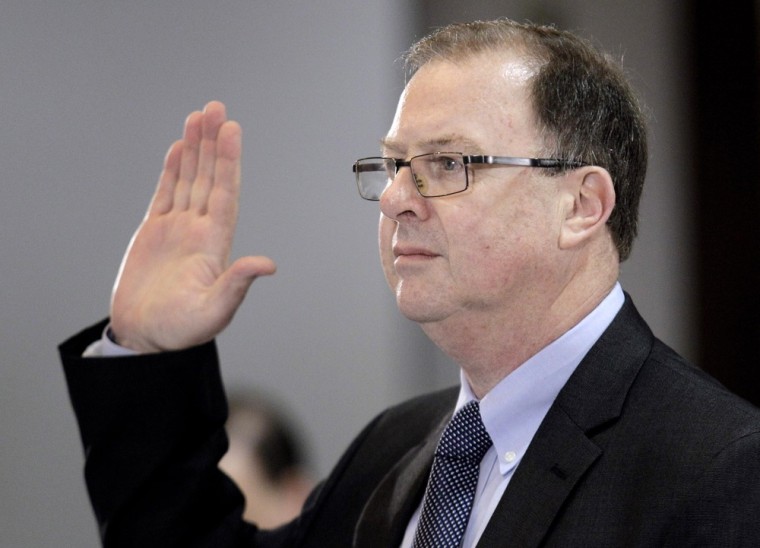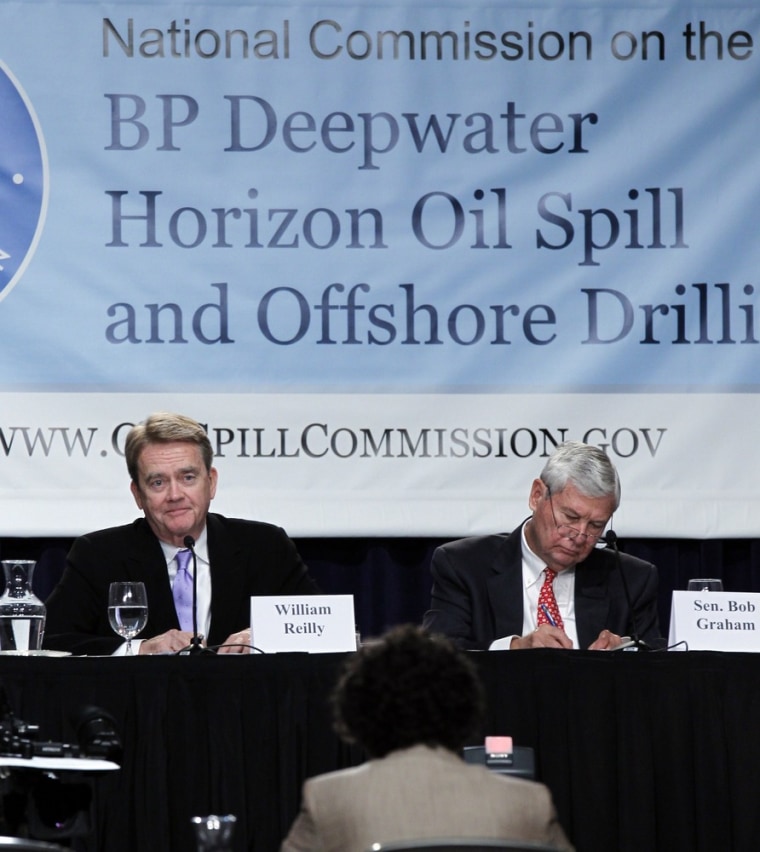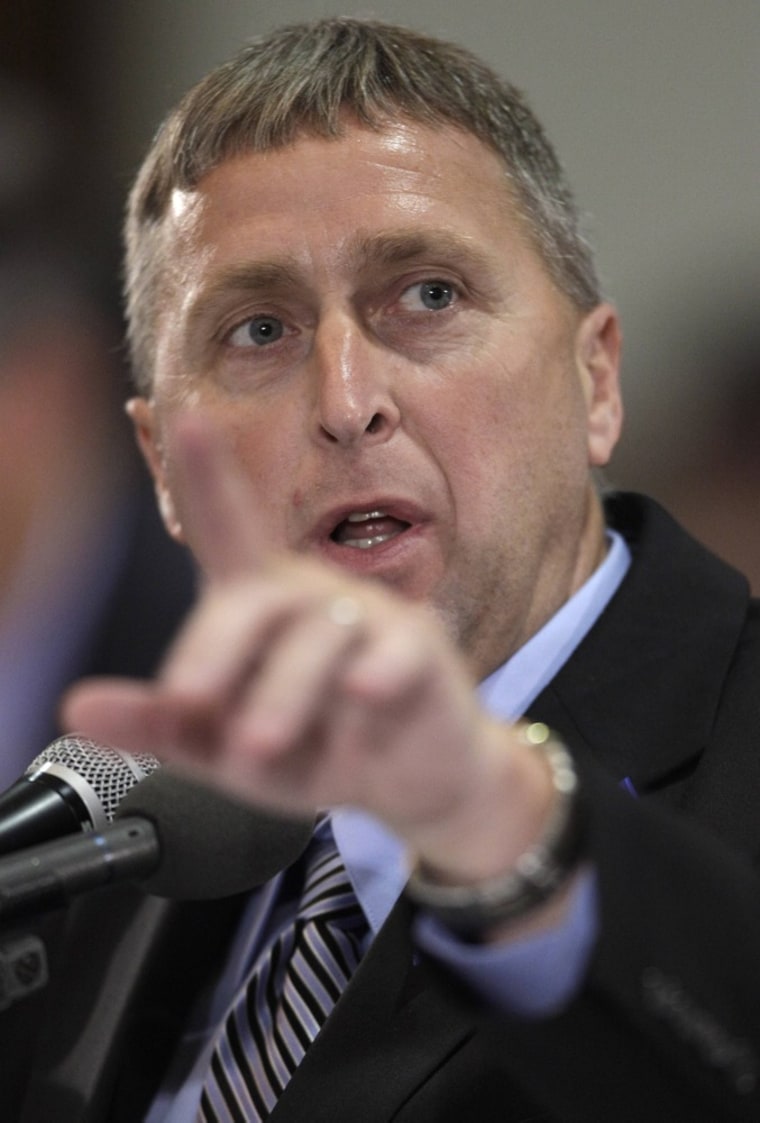A critical device at the center of an investigation into the Gulf oil rig explosion didn't undergo a rigorous recertification process in 2005 as required by federal regulators, a worker responsible for maintaining the equipment told investigators Wednesday.
Mark Hay of rig-owner Transocean said the blowout preventer — designed to prevent a spill in the case of an explosion — was not recertified because it was being constantly maintained. Recertifying the five-story device requires completely disassembling it out of the water and can take as long as three months to complete.
The device — which may be lifted from the seafloor a mile below the water's surface in the coming days — failed following the rig explosion. Government scientists estimate that some 206 million gallons of oil spewed into the Gulf until mid-July, when a temporary cap stopped the flow. A permanent fix is expected to be put in place after Labor Day.
The blowout preventer will be key to the investigation into the April 20 explosion that killed 11 people and caused the biggest oil spill in U.S. history.
Testimony from BP and Transocean officials showed the device had not been recertified according to a three- to-five year timetable laid out by federal regulators; repairs were not always authorized by the manufacturer, Cameron; and in the days after the explosion confusion reined about changes to the equipment, delaying attempts to close the well.
Hay could not say how much it would have cost to recertify the blowout preventer, but said he knew it was functioning because he personally oversaw its maintenance.
The device underwent tests to ensure it was working, he told the joint investigation by the U.S. Coast Guard and the Bureau of Ocean Energy Management, Regulation and Enforcement.
The device, he said, had undergone a maintenance overhaul in February as it was being moved to the Deepwater Horizon to be placed over BP's well.
When asked if he had any doubts April 20 that the device was in full working order, Hay said: "No, sir."
He also detailed getting approval from Transocean's headquarters before making modifications to the device, and in at least one case making a change requested by BP.
Harry Thierens, BP's vice president for drilling and completions, told the federal panel documents detailing the changes to the equipment were not readily available, a waste of critical time after the explosion.
It took between 12 hours and 24 hours to get drawings of changes made to a locking system, Thierens said, and there were other changes and questions.
"If that time had not been necessary a faster response" could have been possible, Thierens said.
During this time, Thierens kept copious handwritten notes in a logbook. Before each item he wrote the hour in military time, then noted key moments from conversations he had with personnel from BP, the operator of the well, and with people from other companies, including Transocean.
Thierens worked closely with Transocean employees to try to activate the preventer with undersea robots beginning four days after the explosion and until it became clear — sometime in early May — that the device was not going to work.
At some point in his log notes, Thierens questions whether Transocean personnel had made changes according to their own protocols. "My concern right now is that Transocean made an ... uncontrolled change on the rig."

It later became apparent that there were a variety of other problems with the device, including pipes being run to different places. Thierens and the other workers trying to shut in the device suddenly learned that after hours of working to build up pressure to one area they were actually doing the work to another part of the device.
"I spoke frankly about the seriousness of this issue and quite frankly was astonished that this could have happened," Thierens wrote. "When I heard this news I lost all faith in the BOP stack plumbing," he added, referring to the device by its acronym.
Billy Stringfellow, a Transocean cementer, was "clearly emotional. Told me 'this stack is plumbed wrong,'" Thierens added.
When pressed, however, Thierens admitted none of it mattered because the blowout preventer didn't work, even when all the other problems were addressed.
Obama panel co-chairs blast policy 'failure'
In Washington, meanwhile, the chairmen of the presidential panel investigating the BP spill voiced anger at what they called failures in both government and industry to regulate offshore drilling for safety.
Bob Graham, a Democrat and former U.S. senator from Florida, said regulators and offshore drillers were aware of the possibility of a major well blowout, such as the one that caused the BP spill, but ignored the risks.
"We should be clear. This disaster represents an enormous and shared failure of public policy," Graham said at the commission's second public meeting.
The seven-member panel, tasked with guiding the future of offshore drilling, questioned environmental groups and the oil sector at the meeting on how to develop a culture of safety capable of preventing and responding to major oil spills.

Bill Reilly, a Republican and the commission's other chairman, questioned whether oil companies were doing enough to blow the whistle when they see unsafe practices elsewhere in the industry.
"If you have a laggard company, there's not much you can do about it, if you're not willing to call them on it," said Reilly, a former head of the Environmental Protection Agency.
Last week, Reilly said his panel was looking at proposing a regulatory structure modeled on the Institute of Nuclear Power Operations. Such a system would aim at ensuring higher safety standards to supplement government regulation, possibly through project evaluations that would be turned over to insurance companies and government agencies.
The Gulf of Mexico oil spill exposed the need for accountability among drillers, Reilly said. As in the nuclear industry, one accident carries steep costs for the entire sector.
Environmental agencies left out
The co-chairs also expressed surprise and disappointment that the Obama administration didn't consult senior U.S. environmental officials before announcing plans last March to expand offshore drilling before the accident.
Nancy Sutley, chairwoman of the Council on Environmental Quality, and Jane Lubchenco, head of the National Oceanic and Atmospheric Administration, admitted after repeated questions that neither played a direct role in the March decision to open up more of the Gulf and Atlantic Ocean to oil and gas drilling.
The exchange suggests that a focus of the federal investigation will be the degree to which federal scientists outside the Interior Department were consulted in oil and gas decisions before the explosion. Federal law leaves the decision on where and when to drill to the Interior Department secretary, who releases plans every five years.
Graham said the panel may press for laws to force the Interior Department to work with NOAA and the CEQ when formulating policy.
"There isn't a culture, and this crosses administrations, that naturally reaches out to the scientists for their participation, therefore it would be appropriate to ask that Congress change the process," Graham said.
Outside "scientists ... based on what I've been told, do not really think they have been adequately consulted or effectively involved in these decisions," added Reilly.
The Obama administration unveiled the expanded exploration plan in March, but it has been put on hold since the BP spill ravaged the Gulf coast.
